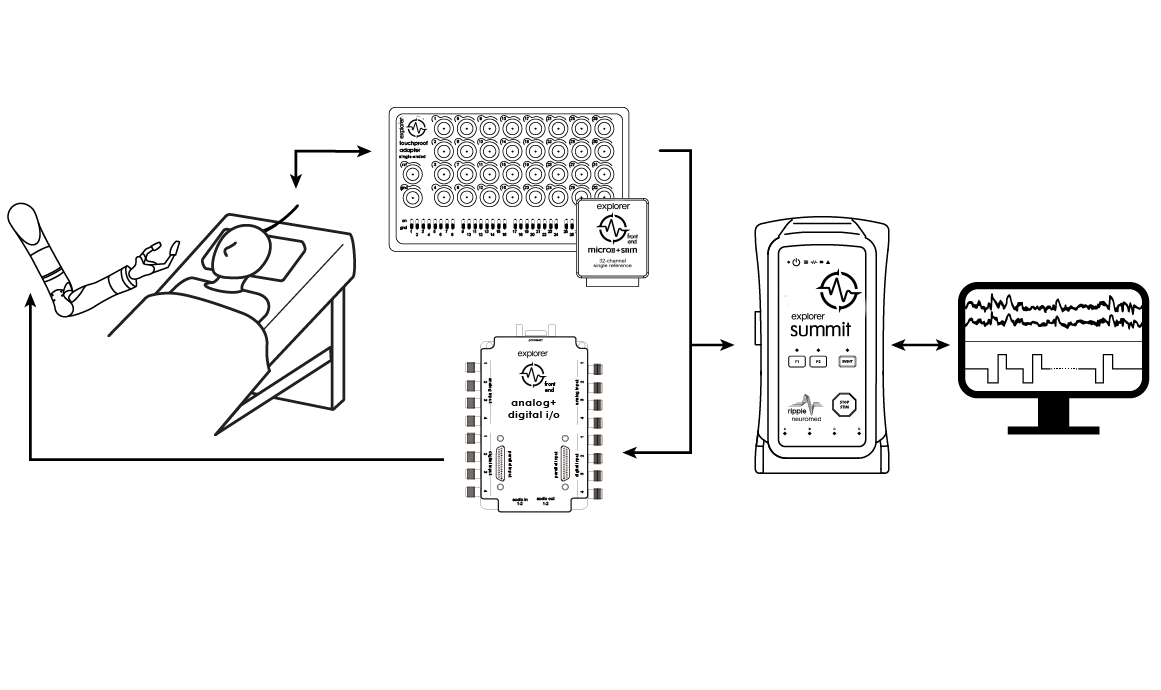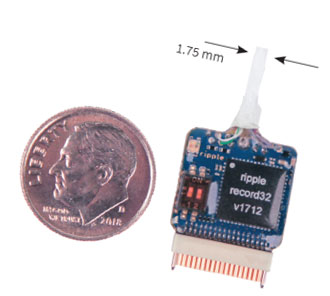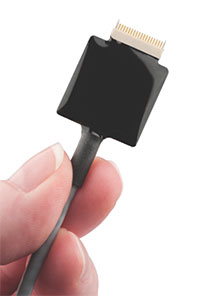Rodent & Small Animal Electrophysiology
Record from multiple subjects at the same time in head-fixed or free-moving paradigms. Integrated digital and analog I/O allow for simultaneous communication and control of external behavioral devices, optogenetic light sources, stimulators, reward delivery devices, or force-feedback devices. On-board processing allows for dynamic experiments that change with the animal’s electrophysiological or behavioral responses. Trellis’ integrated video recording feature provides an easy way to correlate behavior with electrophysiological responses.

Chronic Recording from Freely Moving Subjects
Using our ultra-lightweight pico front ends, you can simultaneously record and electrically stimulate in freely behaving animals. The pico front ends digitize the signal right on the head of the animal, making the signal immune to artifacts from a swinging cable and other sources of noise. Multiple channels can be multiplexed on fewer conductors, providing an extremely light and flexible cable. Our pico commutator is also extremely lightweight, and as a result can be mounted on a balance beam to allow much greater range of motion that retracts the cable to prevent slack. A commutator with a fiber-optic rotary joint is also available, allowing for integration of high quality recording, electrical stimulation, and optogenetic stimulation. Trellis allows connecting multiple inexpensive USB cameras to allow recording from multiple vantage points, with every frame time-stamped and stored with the electrophysiological data. If robust positional tracking or behavioral tracking is needed, we are partnered with Stoelting to provide easy integration with ANY-maze, the gold standard in behavioral tracking software.

Acute or Head-Fixed Recording
Ripple can also provide the physical connections to couple our front ends to a stereotaxic frame. Easily synchronize visual displays, treadmills or track balls, drug delivery devices, optogenetic, sensory or other stimulators, imaging systems or other devices using the robust analog and digital I/O.
Modular and Expandable Systems for High-Throughput Data Collection
Multiple electrically isolated ports allow for recording from multiple subjects at once. The modular design allows the system to grow with your research; increase your channel or subject count at any time by adding more front ends. The Scout processor features a rack-mountable chassis (compatible with 19” racks) with integrated digital and analog I/O. It is capable of record and stimulating on up to 128 channels across up to two animals. For higher channel counts or the ability to record from more subjects, our NIP processor can handle up to 512 channels across up to four subjects (digital and analog I/O are a removeable module, requiring one 128 channel port). Two NIP processors can be linked together to record and stimulate on up to 1024 at once (one or two ports can be used for I/O).
Onboard Processing for Dynamic Experiments and Closed-Loop Electrical, Optogenetic or Sensory Stimulation
Rather than simply streaming data to a PC, powerful on-board Intel processors can process the data on the device for minimal latencies. This gives you complete freedom in designing your experiments, and allows you to create dynamic paradigms that modulate stimuli based on the animal’s physiological and behavioral responses.
| System Specs | ||||||
| System | Maximum Channels | Max Subjects | Max Digital Inputs | Max Digital Outputs | Analog Inputs | Analog Outputs |
| Scout | 128 | 2 | 20, plus 2 strobes | 20 | 28, plus 2 audio | 28, plus 8 audio |
| NIP (single) | 512 (384 with I/O) | 4 (3 with I/O) | 20, plus 2 strobes | 20 | 28, plus 2 audio | 28, plus 8 audio |
| NIP (double) | 1024 (896 with I/O) | 8 (7 with I/O) | 40, plus 4 strobes | 40 | 56, plus 4 audio | 56, plus 16 audio |
System Components
Primate Electrophysiology
Collect synchronized cortical, neuromuscular, analog, and digital signals for real-time decoding with Ripple’s software API.

System Components
Closed-Loop Stimulation
Bench-Top Control
Use Xippmex MATLAB API to program closed-loop algorithms that generate flexible stimulation patterns based on neural activity.

Code-On-The-Box
Use Code-on-the-Box to run algorithms on a Grapevine processor to operate untethered from a PC.

System Components
Brain-Machine Interfaces
The Grapevine System is designed for brain-machine interface (BMI) research. The modular system offers 32 to 512 channels of stimulation and recording and the ability to execute real-time closed-loop programs, making it ideal for translational applications.

System Components
Implantable Technologies
Record EMG and LFP signals with the fully implantable Link-R 32 device. Customize the device by attaching your own electrodes to the implant. Use the Link in conjunction with the microelectrode front ends to correlate muscle and neural activity.
Primate Applications

Large Animal Applications

System Components
EEG, EMG and ECoG
Human EEG
The Summit processor, combined with the Surf S Front Ends, enables portable, freely-moving human EEG experiments. Ripple offers custom adapters to connect to commercial EEG Caps.

EMG With Functional Electrical Stimulation
Stimulate nerve or muscle for functional movement restoration while recording EMG and movement parameters (i.e. force, joint angle, etc.) for closed-loop control.











